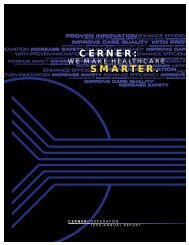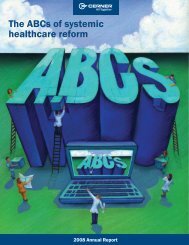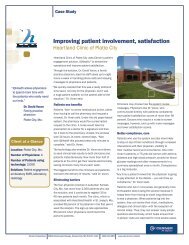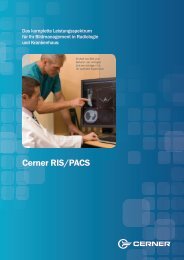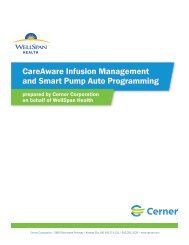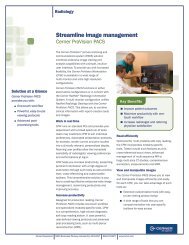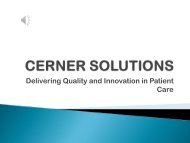Cerner's Olympus Whitepaper - Cerner Corporation
Cerner's Olympus Whitepaper - Cerner Corporation
Cerner's Olympus Whitepaper - Cerner Corporation
Create successful ePaper yourself
Turn your PDF publications into a flip-book with our unique Google optimized e-Paper software.
<strong>Cerner</strong>’s <strong>Olympus</strong> <strong>Whitepaper</strong><br />
Version 3.1.0<br />
February 2011<br />
<strong>Cerner</strong> <strong>Corporation</strong> 2800 Rockcreek Parkway, Kansas City, MO 64117 866.221.8877 www.cerner.com
Table of Contents <br />
Introduction ........................................................................................................................................................... 3<br />
Benefits ................................................................................................................................................................... 3<br />
Architecture ........................................................................................................................................................... 5<br />
Licensing ................................................................................................................................................................. 6<br />
Implementation ...................................................................................................................................................... 6<br />
Minimum Hardware Requirements .................................................................................................................................... 6 <br />
Functionality .......................................................................................................................................................... 8<br />
<strong>Olympus</strong> Command & Control ........................................................................................................................................... 8 <br />
Core Millennium Services .......................................................................................................................................... 8 <br />
Millennium Interface Services ................................................................................................................................. 10 <br />
Operating System Services ...................................................................................................................................... 10 <br />
<strong>Olympus</strong> Security ..................................................................................................................................................... 11 <br />
<strong>Olympus</strong> Alerting .............................................................................................................................................................. 12 <br />
Auditing Alerting ..................................................................................................................................................... 12 <br />
Backend Server Alerting .......................................................................................................................................... 12 <br />
Code Cache Alerting ................................................................................................................................................ 12 <br />
Interface Alerting .................................................................................................................................................... 12 <br />
MQ Series Alerting .................................................................................................................................................. 13 <br />
Operating System Alerting ...................................................................................................................................... 13 <br />
Operations Alerting ................................................................................................................................................. 13 <br />
RRD Alerting ............................................................................................................................................................ 14 <br />
RTMS Alerting .......................................................................................................................................................... 14 <br />
<strong>Olympus</strong> Recovery Action Scripts ..................................................................................................................................... 14 <br />
<strong>Olympus</strong> Dashboard ......................................................................................................................................................... 14 <br />
<strong>Olympus</strong> Smart Modules .................................................................................................................................................. 15 <br />
<strong>Olympus</strong> Smart Module Alerting ...................................................................................................................................... 16 <br />
724Access Smart Module Alerting .......................................................................................................................... 16 <br />
Chart Server Smart Module Alerting ....................................................................................................................... 16 <br />
CPDI Smart Module Alerting ................................................................................................................................... 16 <br />
High Availability Smart Module Alerting ................................................................................................................. 17 <br />
Multum Smart Module Alerting .............................................................................................................................. 17 <br />
Oracle Smart Module Alerting ................................................................................................................................. 17 <br />
WebSphere Smart Module Alerting ........................................................................................................................ 18 <br />
2
Introduction<br />
Management and monitoring of a <strong>Cerner</strong> Millennium ® environment can be challenging. It requires a combination of tools, scripts and 3 rd party<br />
solutions. Recognizing the need for a single console, management architecture, <strong>Cerner</strong> developed the <strong>Olympus</strong> solution. The purpose of this<br />
document is to provide technical information about the <strong>Olympus</strong> solution, including: architecture, functionality and a solution roadmap.<br />
<strong>Cerner</strong>’s <strong>Olympus</strong> solution provides a single console to manage a <strong>Cerner</strong> Millennium environment, allowing the management of systems across all<br />
architectural platforms from one location. <strong>Olympus</strong> unifies the many tool sets previously required to administer <strong>Cerner</strong> Millennium, thereby<br />
improving manageability and access to critical sub-systems within <strong>Cerner</strong> Millennium.<br />
<strong>Olympus</strong> was designed with three main objectives:<br />
■ Command and Control: Provides the ability to effectively manage <strong>Cerner</strong> Millennium from a single console. Examples of Command and<br />
Control include managing application servers, modifying the Millennium Registry, managing print queues, and managing chart requests. A full<br />
functionality list is detailed later in this document. <strong>Olympus</strong> Command and Control streamlines <strong>Cerner</strong> Millennium maintenance by providing<br />
troubleshooting and issue resolution toolsets for multiple platforms in a unified console.<br />
■ Monitoring: The <strong>Olympus</strong> Thresholding & Alerting Engine provides the ability to monitor environments and generate events (e-mails and<br />
pages) when thresholds are crossed. <strong>Olympus</strong> can set thresholds against any captured data point. The Thresholding & Alerting Engine<br />
facilitates proactive monitoring of a <strong>Cerner</strong> Millennium environment.<br />
■ Performance Analysis: Using the historical data captured by <strong>Olympus</strong> in combination with RTMS data, <strong>Olympus</strong> allows users to analyze system<br />
and application performance.<br />
Benefits<br />
The <strong>Olympus</strong> solution unifies more than 40 toolsets previously required to manage <strong>Cerner</strong> Millennium, thereby greatly reducing the time and effort<br />
required to manage an environment. For example, cycling all instances of a server across a domain can take several command-line entries, but<br />
with <strong>Olympus</strong> this can be accomplished in a few mouse clicks. Additional benefits include:<br />
■ A single console for all <strong>Cerner</strong> Millennium architectural platforms (AIX, VMS, HP-UX, Linux, Windows)<br />
■ Streamlining of the time and effort required to manage <strong>Cerner</strong> Millennium<br />
■ Reduction of the number of backend user accounts previously required to manage <strong>Cerner</strong> Millennium<br />
■ Increased security with custom roles to fit your environment and grant permissions on user basis<br />
■ Auditable actions of changes made to a system, when they were made, and by whom.<br />
Architecture<br />
Overview<br />
The <strong>Olympus</strong> architecture was designed to separate systems management from <strong>Cerner</strong> Millennium. <strong>Olympus</strong> operates independently from <strong>Cerner</strong> <br />
Millennium, allowing users to manage Millennium even when components of Millennium are not available. Below are the technologies and<br />
components that comprise the <strong>Olympus</strong> architecture.<br />
JMX<br />
The foundation of the <strong>Olympus</strong> architecture is built on the industry standard JMX (Java Management Extensions). JMX technology manages<br />
resources by Java objects called MBeans (management beans). The MBeans are registered to the MBean Server (JMX Server). The JMX Server<br />
acts as management agent and can run on java-enabled platforms. For additional information on JMX, visit<br />
http://java.sun.com/j2se/1.5.0/docs/guide/jmx.<br />
<strong>Olympus</strong> Console<br />
The <strong>Olympus</strong> console is the user interface built on Java Eclipse technology. The console provides a centralized interface for <strong>Cerner</strong> Millennium <br />
management. The <strong>Olympus</strong> console comes out of the box with four default views that allow users to maneuver through the console in the way<br />
that’s most convenient for the task at hand. The default views are:<br />
■ Server View: Displays by node name<br />
■ Profile View: Displays by profile/function (i.e. Citrix, backend, etc.)<br />
■ Service View: Displays by the service they offer<br />
■ Domain View: Displays by <strong>Cerner</strong> Millennium domain<br />
In addition to the default view users can create custom views to meet their specific needs. These custom views can then be saved as<br />
perspectives to be displayed again at any time. The <strong>Olympus</strong> console allows users to “drag and drop” windows and arrange them in a manner<br />
that is most convenient to the user (all user settings and preferences are saved upon exiting the application).<br />
The console is a rich client and can be deployed in three ways: local installed application, via network share or Citrix published application.<br />
3
Sentinel<br />
Sentinel is installed on each system that is managed by <strong>Olympus</strong>. Sentinel is the process responsible for starting and managing the JMX server.<br />
The Sentinel configuration contains the information required by the JMX server to start and stay running. That information includes:<br />
■ LDAP URL: LDAP server that contains all <strong>Olympus</strong> configuration and security data<br />
■ Profile: The profile defines which services the server has to offer<br />
■ JVM parameters: These parameters include the directory to Java command and memory allocation<br />
■ Credentials: Credentials are required to authenticate the JMX server<br />
MBeans<br />
MBeans (management beans) are Java objects that provide data and perform actions (command and control) to change the state of underlying<br />
sub-systems. MBeans are installed on systems that are managed by <strong>Olympus</strong> and provide the key architecture enabler to allow for centralized<br />
management (in conjunction with the <strong>Olympus</strong> console). For the remainder of this document, MBeans are referred to as “Services.” A complete<br />
list of Services and functionality is included in this document.<br />
LDAP<br />
LDAP (Lightweight Directory Access Protocol) is a network protocol used to access and modify directory services. The LDAP server stores the<br />
<strong>Olympus</strong> security and configuration data, which is housed in dedicated LDAP instance. Supported LDAP servers are Microsoft Active Directory<br />
Application Mode (ADAM) and Oracle Internet Directory (OID). This LDAP instance is a standalone instance and does not require any modifications<br />
to your corporate active directory.<br />
Guardian<br />
Guardian consists of two components: a service responsible for collecting data from managed systems; and a database. The Guardian service<br />
may be thought of as an “Unattended <strong>Olympus</strong> User:” it collects data by invoking the same MBeans that an interactive user employs through the<br />
<strong>Olympus</strong> console. The Guardian service is also responsible for the Alerting and Thresholding Engine. The data points collected by the service are<br />
stored in the Guardian database for historical reference. Currently, both Oracle and MySQL are supported databases. The Guardian service<br />
manages the database by summarizing and purging data at scheduled intervals. Multiple Guardian services and databases may be deployed to<br />
support a large-scale <strong>Olympus</strong> environment.<br />
Security<br />
<strong>Olympus</strong> security supports LDAP authentication (Oracle Internet Directory or Microsoft Active Directory), eliminating the need for additional user<br />
IDs and passwords for console login. Administrators in the <strong>Olympus</strong> security model have the ability to create custom roles to fit their specific needs<br />
for individual users or groups of users. For example, a specific role could be created for an interface team. This role might have access to the<br />
Open Engine (OEN) servers and transactions, but not to the MQ queues, the Millennium registry, or Operations Jobs. Roles may be further<br />
customized to allow or disallow actions in each area. User Security is based on the following items:<br />
■ User ID<br />
■ Role<br />
■ System/Domain Role (Production vs. Non-production)<br />
■ Enterprise (logical grouping of nodes and domains)<br />
4
<strong>Olympus</strong> Architectural Diagram<br />
5
Licensing<br />
There are two <strong>Olympus</strong> components that require licensing:<br />
■ <strong>Olympus</strong> Thresholding & Alerting: The Thresholding & Alerting Engine enables users to proactively monitor the <strong>Cerner</strong> Millennium application<br />
by generating e-mails and pages when parameters cross an established threshold.<br />
■ <strong>Olympus</strong> Smart Modules for: <strong>Olympus</strong> Smart Modules enable clients to monitor and manage the technologies that support <strong>Cerner</strong> Millennium,<br />
such as Oracle, WebSphere, High Availability (HA), PACs, and more.<br />
The <strong>Olympus</strong> Thresholding & Alerting Engine is offered as an Enterprise license. <strong>Olympus</strong> Smart Module s are offered either as an Enterprise<br />
license, or "Ala Carte" pricing. An Enterprise <strong>Olympus</strong> Smart Module License entitles a client to any available <strong>Olympus</strong> Smart Modules, as well as<br />
any new subsequent releases. <strong>Olympus</strong> Smart Module Ala Carte licenses are purchased on a per-Smart Module basis, and offer licensing<br />
flexibility for those clients who are only interested in specific Smart Modules. No matter the choice -- Enterprise or Ala Carte -- <strong>Olympus</strong><br />
Thresholding & Alerting and Smart Module Licensing give clients the ability to deploy to unlimited servers, with no reoccurring Licensing costs.<br />
See your Technology Sales Executive for details on pricing.<br />
Note: <strong>Olympus</strong> Command & Control functionality does not require licensing and is included in annual <strong>Cerner</strong> Millennium Maintenance.<br />
Implementation<br />
<strong>Olympus</strong> Thresholding & Alerting implementation is two weeks of engagement services which includes implementation, configuration, event<br />
notification tuning, and knowledge transfer. <strong>Olympus</strong> Smart Module implementation is one additional week of services for implementation,<br />
configuration, and knowledge transfer. See your Technology Sales Executive for pricing and scope.<br />
Minimum Hardware Requirements<br />
■ LDAP, Guardian, and Guardian Database Server(s)<br />
The LDAP Server is the server on which the ADAM instance will be installed. A Guardian Server is a server on which the Guardian (data<br />
collector) Service runs. A Guardian Database Server is a server on which the Guardian Database runs. Servers may be Virtual Machines if all<br />
other requirements are met.<br />
<strong>Olympus</strong> Installation Requirements vary on the size of each Millennium implementation. For ease of identification, this section has been<br />
divided between Small, Medium, and Large clients.<br />
<strong>Olympus</strong> Command & Control Only<br />
6
<strong>Olympus</strong> Alerting/Enterprise – Up to 300 Servers<br />
<strong>Olympus</strong> Alerting/Enterprise – Over 300 Servers<br />
■ Managed System: A system/server (Back-end, Citrix, RRD, etc) managed by <strong>Olympus</strong><br />
- Disk Space:<br />
- 1 GB of Free Disk Space on AIX, HP-UX, Linux, VMS servers<br />
- 200 MB of Free Disk Space on Windows systems<br />
- Minimum JRE (Java Runtime Environment) Version*<br />
a. AIX – 1.4.2 SR6<br />
b. VMS – 1.4.2-5<br />
c. Windows 1.4.2_13<br />
*Note: Required JRE Version may be installed at time of implementation. It does not require complete system Java upgrade and will not affect other programs utilizing <br />
Java. <br />
7
Functionality<br />
This section details <strong>Olympus</strong> features and functionalities and is divided into: <strong>Olympus</strong> Command & Control Functionality; <strong>Olympus</strong> Alerting; and<br />
<strong>Olympus</strong> Smart Modules<br />
OLYMPUS COMMAND & CONTROL<br />
Core <strong>Cerner</strong> Millennium Services <br />
Service Description Actions<br />
Backend Servers<br />
Clinical Reporting<br />
DeviceViewer*<br />
Enterprise<br />
Authentication*<br />
Manage <strong>Cerner</strong> Millennium Application Servers<br />
(functionality equivalent to SCPView and SPSMON)<br />
Manage <strong>Cerner</strong> Millennium Chart Requests<br />
(functionality equivalent to Chart Request<br />
Maintenance)<br />
DeviceViewer Functionality with additional<br />
enhanced features<br />
*Requires Millennium 2007.13 or higher for full<br />
functionality<br />
New service for user maintenance and reporting<br />
*Requires Millennium 2007.18 or higher<br />
- Start, Stop, Cycle (single or across domain) Server Instances<br />
- View and Modify Server Definitions<br />
- OS detail for Server Instances (CPU, Memory)<br />
- View all <strong>Cerner</strong> Millennium Services (including shared services)<br />
- Server Activity view [Requires minimum Millennium 2005.02.43]<br />
- View server deficits and overages<br />
- View server-service and service-server relationships<br />
- Prompting for modification of protected servers<br />
- Export Server Definitions to, and import from, SCP files<br />
- Compare Server Definitions between two nodes, two SCP files, or<br />
a node and a SCP file<br />
- Server Groups can be defined for backend servers, allowing<br />
monitoring and managing of a subset of servers. Users may be<br />
given access to manage only specific server groups.<br />
- Server Notes can be created and edited for all servers in<br />
<strong>Olympus</strong>. Notes are visible in many Server management views<br />
- View Chart Request Statistics, Details, and Statuses<br />
- View by All Servers or Specific Chart Request Servers<br />
- Re-submit Chart Requests<br />
- Search Chart Requests with robust filters<br />
- View and manage the following devices in the Millennium<br />
database: Printers, Print Queues, Nodes, Faxes, Ports, Scanners<br />
- View and manage output destinations in Millennium database<br />
- View and control back end queues<br />
- View Device Cross References in the Millennium database.<br />
- Define New Printers via Import Tool, including LRS definitions<br />
- Within a specified timeframe, view the following authentication<br />
information:<br />
- Authenticated users<br />
- Failed authentications<br />
- Locked users<br />
- User Activity<br />
- Ability to lock/unlock user from further Millennium activity<br />
- Ability to lock out all users for downtime maintenance<br />
Global Section View CMB Global Section - View Global Section Tables<br />
Health Maintenance<br />
Management<br />
Logicals<br />
View Health Expert Jobs<br />
Manage Operating System Logicals (Environment<br />
Variables)<br />
- View Health Expert Jobs<br />
- Modify Health Expert Job Size and Intervals<br />
- View Logicals by Environment<br />
- Add/Delete/Update Logicals<br />
- Compare Logicals between nodes and domains<br />
- Copy Logicals between nodes and domains<br />
- Permanently save Logicals to the <strong>Cerner</strong> Registry<br />
8
Core <strong>Cerner</strong> Millennium Services (continued) <br />
Service Description Actions<br />
Message Log<br />
Millennium<br />
Management<br />
Operations<br />
Order Format Validation<br />
Manage Millennium Message Logs (functionality<br />
equivalent to System Message View, Message View<br />
and Message View Win)<br />
View and Compare Code Sets<br />
Event Code and Event Set Management<br />
Domain Maintenance<br />
Manage Operation Jobs and Servers (functionality<br />
equivalent to OpsView Monitor)<br />
Performs static analysis on a given order entry<br />
format to help identify potential build issues that<br />
may affect the order entry system.<br />
- View, Browse, and Search Logs<br />
- Export Logs to CSV<br />
- Search Multiple Message Logs on Multiple Servers (both<br />
Millennium Application and Citrix) in Single Search<br />
- View Code Set differences between that which is loaded into<br />
cache and defined in the <strong>Cerner</strong> database<br />
- Repair Code Sets by synching cache with the database<br />
- Load and Unload Event Codes and Event Sets<br />
- Start/Stop and Set Millennium Components<br />
- Manage Control Group Servers<br />
- View by Status, Control Group, or Scheduled Tasks<br />
- View Job Step Details<br />
- Start/Stop/Initialize Tasks<br />
- Binding/Skip/Reset Job groups<br />
- Server Notes can be created and edited for all servers in<br />
<strong>Olympus</strong>. Notes are visible in many Server management views<br />
- Validation for all formats and action formats, with specifics for<br />
General Laboratory and Pharmacy formats.<br />
- View color-coded validation results that range from Success,<br />
Informative Warning, and Error<br />
PowerNote Maintenance Perform PowerNote maintenance tasks - Delete the PowerNote Cache<br />
- Export/Import notes created in PowerNote<br />
- Upload PowerNote files<br />
- Import paragraphs<br />
Queuing<br />
Registry<br />
Manage <strong>Cerner</strong> Millennium MQ (functionality<br />
equivalent to QCPView)<br />
Manage <strong>Cerner</strong> Millennium Registry (functionality<br />
equivalent to LRegView)<br />
- Start and Stop Queue Managers<br />
- View and Modify Queue Properties<br />
- Manage and Create Queue Channels<br />
- View, Re-queue, and Purge Queued Transactions<br />
- Manage Registry<br />
- Add/Delete/Copy Keys and Properties<br />
- Manage Registry Locks and Sessions<br />
RTMS View and Analyze RTMS Data in “Real Time” - View Raw Data<br />
- View User Response Time Graphs<br />
- Advanced Filtering for Data Analysis<br />
- New framework for RTMS collection and checkpoint<br />
measurement<br />
- View collected RTMS Timers from Guardian database<br />
- View both RTMS v3 and v4 timers in a consolidated window<br />
RRD<br />
View RRD Statistics (functionality equivalent to<br />
separate database query scripts)<br />
- View All Stations or Specific Stations<br />
- View Transmission Status<br />
- Change fax status<br />
- View, enable, and disable RRD ports<br />
- View RRD Session Logs<br />
- View RRD Modem Pools and Ports<br />
- View quick Error Code reference information<br />
9
Core <strong>Cerner</strong> Millennium Services (continued) <br />
Service Description Actions<br />
Volume Reports<br />
View <strong>Cerner</strong> Millennium Application Statistics<br />
(Functionality Equivalent to Database Monitoring<br />
Tools)<br />
- FirstNet, Orders, PathNet, Patient Management, Personnel,<br />
RadNet, Scheduling Reports<br />
Millennium Interface Services <br />
Service Description Actions<br />
ESI<br />
ESO<br />
OEN (Open Engine)<br />
View ESI Statistics (functionality equivalent to<br />
separate database query scripts)<br />
View ESO Statistics (functionality equivalent to<br />
separate database query scripts)<br />
Manage FSI and MDI Interfaces (functionality<br />
equivalent to OpenView Controller and separate<br />
HL7 viewer)<br />
-View ESI Volumes Statistics (Message and System)<br />
- Query for ESI transactions in a specific time range<br />
- Filter by only failed ESI transactions<br />
- View contributor system, error text, and other pertinent data<br />
for each transaction<br />
- View all HL7 messages associated with a failed ESI transaction<br />
- View ESO Volumes<br />
- View real-time graph of TR1, Notify, and OCC ESO Queue<br />
depths<br />
- Start/Stop Interfaces<br />
- View Interfaces Statistics<br />
- View Queued Transactions<br />
- View In-bound/Out-bound HL7 messages<br />
- Search HL7 messages for text strings<br />
- Server Notes can be created and edited for all servers in<br />
<strong>Olympus</strong>. These Notes are visible in many Server management<br />
views<br />
- Replay messages for any outbound COM server from the Open<br />
Engine CQM (Common Queuing Model) tables<br />
Operating System Services <br />
Service Description Actions<br />
Dr. Watson<br />
Manage Dr Watson and Crash Collector for Citrix<br />
Servers<br />
- Configure Dr. Watson and Crash Collector<br />
- FTPs Crash Files to <strong>Cerner</strong><br />
- View Dr. Watson Crash Summary Logs<br />
File System View File Systems and Disk Performance For all platforms (AIX, HP-UX, Linux, Open VMS, Windows):<br />
- View File System Utilization<br />
- View I/O Statistics<br />
- File Browser<br />
- View Disk performance<br />
- Perform File Transfer to and from a Managed Server<br />
- Text File Viewer<br />
10
Operating System Services (continued) <br />
Service Description Actions<br />
Operating System View Operating System Statistics and Properties For all platforms (AIX, HP-UX, Linux, Open VMS, Windows):<br />
- View Server CPU, Memory, and Network Statistics<br />
- View Individual Process CPU/Memory Statistics<br />
- View Running Processes<br />
- View Process Detail<br />
- View System Properties (OS Version, Machine Name, Time Zone,<br />
CPU Count, Total Memory)<br />
- Display process name in process view (not just executable<br />
name)<br />
- Terminate running processes<br />
- View top CPU-consuming processes<br />
- View process Page Faults<br />
Printers Manage Backend Print Queues and Print Jobs - View All Print Queues<br />
- View Queue Detail<br />
- Start/Stop Queue<br />
- Hold/Release/Delete Print Jobs<br />
- Search for Print Queues and easily see their statuses and queue<br />
depths<br />
- Ping a printer to determine its availability<br />
Windows Event Log View Event Logs (Application, Event, System) - View and Search Windows Events Logs<br />
Windows Registry View Windows Registry - View, Search, and Modify Windows Registry<br />
Windows Services Manage Windows Services - View Windows Services<br />
- Start/Stop/Restart Windows Services<br />
- View Service Details<br />
<strong>Olympus</strong> Security and Administration <br />
Service Description Actions<br />
Auditing<br />
Deployment Service<br />
Creates an Audit Log of Actions Performed in<br />
<strong>Olympus</strong><br />
Allows for centralized deployment and upgrades of<br />
<strong>Olympus</strong> environments<br />
- View what changes have been made to the system, when the<br />
changes were made, and by whom in a centralized location with<br />
searchable filters<br />
- Deploy bundles of updates with which Servers can automatically<br />
upgrade themselves.<br />
Enhanced Security Control and configure security access to <strong>Olympus</strong> - Add and configure new users, roles, and levels of access to each<br />
service<br />
- Search users<br />
- Configure Auditing categories<br />
<strong>Olympus</strong><br />
Administration<br />
Configure and manage <strong>Olympus</strong> infrastructure<br />
- Deploy new Sentinel installations and upgrades to backend<br />
nodes from the console<br />
- Modify and deploy Sentinel configuration (sentinel.config)<br />
- Retrieve Domains and Database info<br />
- Cycle Sentinel servers from the console<br />
- Cycle JMX servers from the console<br />
11
OLYMPUS ALERTING<br />
*Requires Thresholding & Alerting Licensing or Enterprise Licensing <br />
Auditing Alerting<br />
Parameter<br />
Description<br />
Audit Event<br />
Monitors <strong>Olympus</strong> Auditing Events and notifies when a specific event is detected<br />
Backend Server and Service Alerting<br />
Parameter<br />
Description<br />
Server Connections<br />
Server Definition Change<br />
Server Exceptions<br />
Server State<br />
Server Working State<br />
Service Message Count<br />
Service Message Count<br />
The number of Connections to each Server Instance<br />
Indicates that a modification to a server definition or one of its properties has occurred<br />
Indicates that the number of Server Instances running for a particular Server does not equal its<br />
defined count (covers both Deficit and Overage conditions)<br />
Indicates that a Server Instance has been in an abnormal state (starting or stopping) for longer<br />
than a specified period of time<br />
Indicates that a Server Instance is in a Working State for longer than a specified period of time<br />
Indicates the number of Messages a Service (Connected or Shared) is currently processing<br />
Indicates the total number of Messages that a Service (Connected or Shared) has processed<br />
Code Cache Alerting<br />
Parameter<br />
Code Cache Difference<br />
Description<br />
Monitors the Millennium Code Cache and alerts when it is out of synch with the database<br />
Interface Alerting <br />
Parameter<br />
ESI Fail Count<br />
ESI Log Entry<br />
ESI Max Time<br />
ESI Retry Count<br />
ESO Message Count<br />
ESO Notify Queue Depth<br />
ESO OCC Queue Depth<br />
ESO TR1 Queue Depth<br />
Open Engine In Cycle Time<br />
Open Engine Interface State<br />
Open Engine Orphaned Trigger<br />
Open Engine Out Cycle Time<br />
Open Engine Out Cycle Lag<br />
Open Engine Transaction Count<br />
Description<br />
Number of ESI transaction failures for a message type<br />
Monitors ESI Log Entries for errors<br />
Maximum ESI transaction completion time for a message type<br />
Number of ESI transaction retries for a message type<br />
Number of ESO transactions sent for a message type<br />
Monitors the depth of the ESO Notify Queue<br />
Monitors the depth of the ESO OCC Queue<br />
Monitors the depth of the ESO TR1 Queue<br />
Last time a transaction was queued in for each OEN interface<br />
Indicates the State of each OEN Interface<br />
Indicates that an orphaned trigger exists<br />
Last time a transaction was processed for each OEN interface<br />
Indicates that an OEN Interface may be stalled<br />
Number of queued transactions for each OEN Interface<br />
12
OLYMPUS ALERTING (CONTINUED)<br />
*Requires Thresholding & Alerting Licensing or Enterprise Licensing <br />
MQ Series Alerting <br />
Parameter<br />
Description<br />
MQ Local Queue Depth<br />
MQ Local Queue Depth Percentage<br />
MQ Local Queue Growth<br />
MQ Local Queue Input/Output<br />
Mismatch<br />
MQ Queue Manager Status<br />
MQ Queue Manager Change<br />
MQ Local Queue Oldest Message Time<br />
MQ Local Queue Put and Get Enabled<br />
Queued depth of each MQ Local Queue<br />
Queued depth of each MQ Local Queue as a Percentage of its maximum queue depth<br />
Difference of each Local MQ Queue’s queued depth between the last polling cycle and the<br />
current polling cycle. Indicates whether the Local MQ Queue is growing or shrinking.<br />
Monitors Local Queues and alerts if there are publishers but no subscribers<br />
Status of each MQ Queue Manager<br />
Monitors when the status of an MQ Queue Manager changes<br />
Age of the oldest queued message in each MQ Local Queue (minutes)<br />
Indicates whether each MQ Local Queue may have messages put to and taken from (queued<br />
and de-queued).<br />
Operating System Alerting <br />
Parameter<br />
CPU Run Queue<br />
CPU Utilization<br />
File Contents<br />
Logical Disk Bytes Available<br />
Logical Disk Space Percentage Used<br />
Physical Memory Percentage Used<br />
Print Queue Status<br />
Process Count<br />
Description<br />
CPU Run Queue count on a server<br />
CPU Utilization (%) of all CPU’s on a server<br />
Monitors the contents of a text file for a specified string<br />
Available space (in Bytes) for each logical disk on a server<br />
Percentage of used space for each logical disk on a server<br />
Percentage of Physical Memory Used on each server<br />
Status of each Print Queue on each server<br />
Number of running instances of a specified process (Process Presence)<br />
Process CPU Utilization Processes that have exceeded a specified amount of used CPU (%)<br />
Process Physical Memory<br />
Processes that have exceeded a specified amount of used Physical Memory (in Bytes)<br />
Virtual Memory Used Measures the amount of Virtual Memory Used on each server (%)<br />
Windows Service State<br />
Indicates the State of a particular Windows Service<br />
Operations Alerting <br />
Parameter<br />
Operations Control Group Status<br />
Ops Job Status<br />
Ops Task Change<br />
Ops Template Change<br />
Stalled Ops Jobs<br />
Description<br />
Status of each Operations Control Group<br />
Monitors when Operations Jobs are not in a normal state<br />
Monitors for changes in Operations Tasks<br />
Monitors for changes in Operations Job Templates<br />
Monitors when Operations Jobs are running longer than expected<br />
13
OLYMPUS ALERTING<br />
*Requires Thresholding & Alerting Licensing or Enterprise Licensing <br />
RRD Alerting <br />
Parameter<br />
Description<br />
RRD Port Status<br />
Status of each RRD Port<br />
RTMS Alerting <br />
Parameter<br />
Description<br />
RTMS Timer<br />
Monitors the duration of an RTMS timer<br />
OLYMPUS RECOVERY ACTION SCRIPTS<br />
*Requires Thresholding & Alerting Licensing or Enterprise Licensing <br />
<strong>Olympus</strong> Recovery Script Actions allow scripts to be automatically called when a specified <strong>Olympus</strong> Alerting event occurs <br />
Script<br />
Cycle Server<br />
Enable RRD Port<br />
Requeue Messages<br />
Description<br />
Automatically Cycles Backend Servers intelligently. Supports Server Exceptions, Server Connections, Server<br />
Working State, and Server Definition Change Alerts<br />
Automatically Enables an RRD Port when it becomes disabled<br />
Automatically requeues messages in a given queue<br />
OLYMPUS DASHBOARD<br />
*Requires Thresholding & Alerting Licensing or Enterprise Licensing <br />
Offers an at-‐a-‐glace view of environment health at the Enterprise, Domain, and Node level <br />
Widget<br />
Description<br />
Active Events<br />
CPU<br />
Memory<br />
Queue Depths<br />
Server Exceptions<br />
Shared Services<br />
Working Servers<br />
Displays the Active <strong>Olympus</strong> Alerts<br />
Displays the percentage of CPU Utilization for one or more nodes<br />
Displays the physical and virtual memory used at the Node level. Displays the percentage of<br />
virtual memory used for each Node at the Domain level.<br />
Displays the current depth of the top ten local MQ queues with the highest depth. Data is<br />
displayed in a bar graph.<br />
Displays the server entries in a deficit or overage state<br />
Displays the message count for the top ten shared services with the highest message count.<br />
Data is displayed in a bar graph.<br />
Displays the servers currently in a working state.<br />
14
OLYMPUS SMART MODULES<br />
*Requires Smart Module Licensing or Enterprise Licensing <br />
Service Description Actions<br />
724Access<br />
CPDI<br />
Chart Server<br />
High Availability<br />
View and Manage a 724Access<br />
environment<br />
View and Manage <strong>Cerner</strong> ProVision<br />
Document Imaging Services<br />
View and Manage Legacy (WinWord)<br />
Chart Servers<br />
View High Availability Configuration on<br />
AIX systems<br />
- Displays 724Access topology of Source and Mid-Tier Nodes<br />
- Provides ability to Stop, Start, and Monitor the Manager, Capture,<br />
Pump, and Replicat Processes<br />
- View data flow of Capture, Pump, and Replicat Processes<br />
- View and transfer 724Access and GoldenGate log files<br />
- Displays CPDI topology of Services, Domains, and Nodes<br />
- Provides the ability to Stop, Start, and Monitor the Document<br />
Imaging, Batch Capture, and Content Management Services.<br />
- Displays the Directory Detail of Service Directories<br />
- Displays Detailed Service information, including Queues and<br />
processing throughput<br />
- Displays a detailed view of the Auto Import Folders, including the<br />
watched, processed, and error folders.<br />
- Manage configuration and operations of Chart Servers (WinWordbased).<br />
- Remotely manages Starting, Stopping and configuration changes.<br />
- Suppresses blocking pop-up windows.<br />
- Allows management of multiple chart servers on a domain at once.<br />
- Provides information and statistics on recent request, out files and<br />
actual windows suppressed.<br />
- Displays HA cluster topology of Database and Application nodes<br />
- Checks HA configuration against <strong>Cerner</strong> recommended HA standards<br />
- Allows comparison of nodes in an HA cluster to identify where their<br />
configurations may differ<br />
- Supports HA ATG.2 and HA.ATG.4 scripts<br />
Oracle View Oracle Database Statistics - View DB Instance Health<br />
- View Long Running Transactions<br />
- View Top SQL Statements (by number of disk reads)<br />
- View Tablespace Disk Utilization<br />
- View Archive Destination and Percent Utilized<br />
- View Table Locks and Waiting Transactions<br />
- View Oracle Alert Logs<br />
- View Archive Log Cut Rate<br />
- View Latch Hit Ratios<br />
- View Oracle Tablespace Usage Projections<br />
- View DBA Resumable Events<br />
- View and Manage Oracle Sessions<br />
Multum View health of Multum environment - View Multum server status and response times<br />
- Monitor node-level Multum status attributes as well as Multum SDK<br />
Servers<br />
WebSphere<br />
View IBM WebSphere environment<br />
health<br />
- View cell topology: Cells, Clusters, Nodes, Application Servers,<br />
Applications<br />
- View statuses and attributes of elements in cell topology<br />
- Start, Stop, and Cycle Application Servers<br />
- Supports WAS environments with Application Security<br />
15
OLYMPUS SMART MODULE ALERTING<br />
724Access Smart Module Alerting <br />
*Requires Thresholding & Alerting Licensing and 724Access Smart Module Licensing or Enterprise Licensing <br />
Parameter<br />
Active Sessions<br />
Manager Status<br />
Capture Checkpoint Time<br />
Capture Lag Time<br />
Capture Status<br />
Pump Checkpoint Time<br />
Pump Lag Time<br />
Pump Status<br />
Replicat Checkpoint Time<br />
Replicat Lag Time<br />
Replicat Status<br />
Description<br />
Monitors the elapsed time of Oracle sessions<br />
Monitors Manager Process Status on Source and Mid-Tier nodes<br />
Monitors Capture Process Checkpoint Time<br />
Monitors Capture Process Lag Time<br />
Monitors Capture Process Status<br />
Monitors Pump Process Checkpoint Time<br />
Monitors Pump Process Lag Time<br />
Monitors Pump Process Status<br />
Monitors Replicat Process Checkpoint Time<br />
Monitors Replicat Process Lag Time<br />
Monitors Replicat Process Status<br />
Chart Server Smart Module Alerting <br />
*Requires Thresholding & Alerting Licensing and Chart Server Smart Module Licensing or Enterprise Licensing <br />
Parameter<br />
Chart Server Log Level<br />
Chart Server Printing Enabled<br />
Chart Server Screen Updating<br />
Chart Server State<br />
Description<br />
Monitors Chart Server Log Level Setting<br />
Monitors Chart Server Log Level Setting<br />
Monitors Chart Server Screen Updating Setting<br />
Monitors for a Chart Server not in a RUNNING state<br />
CPDI Smart Module Alerting <br />
*Requires Thresholding & Alerting Licensing and CPDI Smart Module Licensing or Enterprise Licensing <br />
Parameter<br />
Age of Last Processed CPDI Item<br />
Age of Oldest Item<br />
Age of Oldest CPDI Property<br />
Age of Last Processed Batch Capture<br />
Item<br />
Age of Newest Batch Capture Auto<br />
Import Folder Item<br />
Count of Batch Capture Auto Import<br />
Folder Items<br />
Content Management Application<br />
Collision<br />
Description<br />
Monitors the Age of the Last Item Processed by a Specified CPDI Service<br />
Monitors the Age of the Oldest Item in a Specified CPDI Directory<br />
Monitors the Age of the Oldest Specified CPDI Property<br />
Monitors the Age of the Last Item Processed by a Specified Batch Capture Service<br />
Monitors the Age of the Newest Item in the Batch Capture Audio Import Folders of a Specified<br />
Type<br />
Monitors the Count of Items in the Batch Capture Auto Import Folders of a Specified Type<br />
Monitors Content Management Applications for Collision State<br />
16
High Availability Smart Module Alerting <br />
*Requires Thresholding & Alerting Licensing and High Availability Smart Module Licensing or Enterprise Licensing <br />
Parameter<br />
Database Connectivity<br />
CERRDBMS<br />
CCLReconnect<br />
Filesystem Permissions<br />
Filesystem Ownerships<br />
Login Credentials<br />
LREG Settings<br />
MQ Settings<br />
Security Master Settings<br />
Description<br />
Monitors Database Connectivity configuration<br />
Monitors $CER_RDBMS_CONNECT setting in the <strong>Cerner</strong> Registry<br />
Monitors CCLReconnect setting in the <strong>Cerner</strong> Registry<br />
Monitors HA files and filesystem permissions settings<br />
Monitors HA filesystem ownership settings<br />
Monitors HAUser and HAPassword settings in the <strong>Cerner</strong> Registry<br />
Monitors LREG settings for High Availability<br />
Monitors MQ settings for High Availability<br />
Monitors Security Master is configured properly for HA failover<br />
Multum Smart Module Alerting <br />
*Requires Thresholding & Alerting Licensing and Multum Smart Module Licensing or Enterprise Licensing <br />
Parameter<br />
Multum SDK Server Load<br />
Multum SDK Server Status<br />
Multum Service Manager Status<br />
Multum Version Consistency<br />
Description<br />
Load on each Multum Server as a Percentage of its maximum<br />
Status of each Multum Server<br />
Status of each Multum Service Manager<br />
Determines whether Multum versions are consistent across servers in a farm<br />
Oracle Smart Module Alerting <br />
*Requires Thresholding & Alerting Licensing and Oracle Smart Module Licensing or Enterprise Licensing <br />
Parameter<br />
Description<br />
Oracle Archived Logs<br />
Oracle Archive Percentage Used<br />
Oracle Database Mode<br />
Oracle Excessive Disk Reads<br />
Oracle Database Latches<br />
Oracle DBA Resumable<br />
Oracle Instance Active State<br />
Oracle Instance Status<br />
Oracle Locks<br />
Oracle Locks CPU Time<br />
Oracle Logins Allowed<br />
Oracle Long Running Transactions<br />
Oracle Tablespace Percentage Used<br />
Oracle Tablespace Projection<br />
Monitors Oracle Archived Log Cut Rate<br />
Percentage of used Archive space in Oracle database<br />
Current Database Mode Status<br />
SQL statements that have exceeded a specified number of disk reads<br />
Monitors Oracle Latch Hit Ratio<br />
Monitors DBA Resumable Events on the Database<br />
Oracle Instance Active State Status<br />
Oracle Instance Status<br />
Indicates presence of an Oracle Exclusive Lock<br />
Monitors CPU time of Objects that have a Lock or are waiting on a Locked Object<br />
Oracle Logins Allowed Status<br />
Transactions that have exceeded a specified duration of time<br />
Percentage of used space in each Tablespace<br />
Monitors Projection of Time until Tablespace runs out of space<br />
17
WebSphere Smart Module Alerting <br />
*Requires Thresholding & Alerting Licensing and WebSphere Smart Module Licensing or Enterprise Licensing <br />
WAS Free Memory<br />
WAS Heap Size<br />
WAS Status<br />
Parameter<br />
Description<br />
Measures the amount of Memory available for each WebSphere Application Server (Bytes)<br />
Measures the amount of used Heap Size for each WebSphere Application Server (Bytes)<br />
Indicates the State of a particular WebSphere Application Server<br />
18



